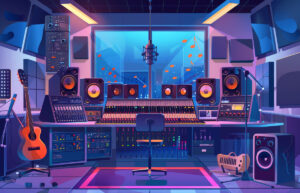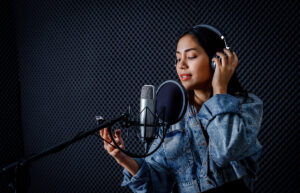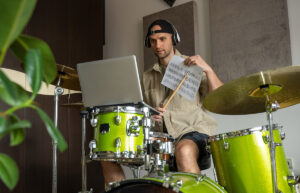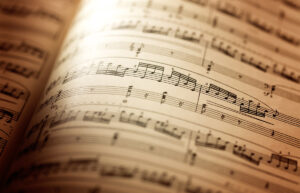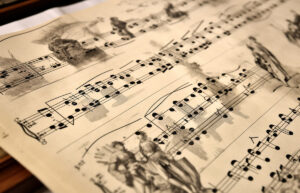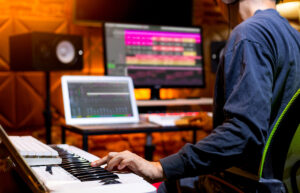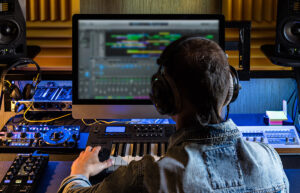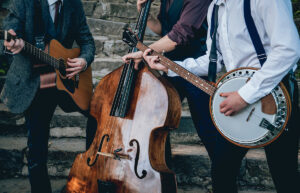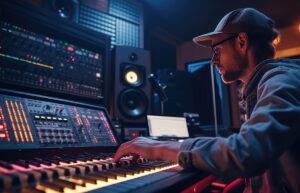What is Sampling in Music: Meaning, History, Types, Uses & Examples

Welcome to the intriguing world of music sampling! Have you ever wondered how your favorite artists create those catchy beats or incorporate snippets of familiar tunes into their songs? Imagine music as a painter’s palette, where sampling serves as the brushstrokes, blending past melodies with modern rhythms and transforming sound into an intricate collage. Join me as we unravel what is sampling in music, exploring its origins, techniques, and the profound impact it has on the tunes we love.
Welcome to TheDemoStop, now join the community!
Connect with artists, fans and producers around the world.
What is sampling in music?
Sampling in music refers to the technique of taking a portion, or a “sample,” of a pre-existing sound recording and reusing it in a new musical composition. This can involve anything from a brief snippet of a song, a drumbeat, a vocal line, or even an ambient sound.
When you learn what is sampling in music, you must also know that producers and artists sample to incorporate specific elements of existing music into their own creations. They manipulate these samples through various technologies like samplers or software to alter pitch, tempo, or other attributes. Sampling allows musicians to create entirely new pieces of music by recontextualizing and combining these samples in innovative ways, shaping the soundscape of various genres, from hip-hop and electronic to pop and beyond.
History of sampling
Sampling in music has its roots in experimental movements of the mid-20th century, such as musique concrète, where composers experimented with recorded sounds. It gained prominence in the late 1970s and 1980s with the rise of hip-hop and electronic music, as DJs like Kool Herc, Grandmaster Flash, and Afrika Bambaataa popularized the practice of looping drum breaks from funk and soul records using turntables, laying the foundation for sampling culture.
A significant breakthrough occurred with the introduction of the Fairlight CMI in the late 1970s, one of the earliest digital sampling synthesizers. It revolutionized music production by allowing musicians to sample sounds, manipulate them, and integrate them into new compositions with ease. In the 1980s, portable digital samplers like the E-mu Emulator and Akai MPC series made sampling more accessible, enabling artists to explore new sonic territories and genres. Today, sampling continues to evolve, with its prevalence increasing in modern music production, often seen in commercially successful pop songs.
Benefits of using samples in music
Creative quality sounds
Samples provide access to professionally recorded sounds, ensuring a level of quality that might be challenging to achieve independently. This access allows musicians to infuse their compositions with layers of authenticity and depth that might not be feasible through in-house recordings alone.
Flexibility
Samples can alter the pitch, tempo, or timbre of samples, apply various effects, or chop and rearrange them to create entirely new sonic textures. This adaptability enables musicians to blend, morph, or tweak samples to fit their compositions perfectly, fostering a unique signature sound.
Time efficiency
Instead of spending hours or days recording multiple instruments or searching for specific sound, producers can quickly access pre-existing samples that match their vision, accelerating the creative process and allowing them to focus on refining other aspects of their music.
Specialization
Samples grant access to specialized instruments, rare sounds, or cultural elements that may not be readily available to every musician. This access enables artists to diversify their musical palette, incorporating unique sounds or instruments from different cultures, eras, or genres, thereby enriching their compositions with distinct sonic flavors.
Creative freedom
Leveraging samples provides an avenue for unbounded experimentation and creativity. Musicians can combine disparate sounds, blend genres, or even create entirely new musical genres by manipulating samples. This freedom allows for unconventional sonic explorations, pushing the boundaries of traditional music production and fostering innovation within the industry.
Sampling techniques in music
Layering
This technique involves stacking multiple samples or sounds on top of each other within a composition. Musicians use layering to create depth, richness, and complexity by blending various samples, instruments, or textures to produce a cohesive and intricate sound.
Changing tempo
Altering the tempo of a sample involves adjusting its speed to match the desired tempo of the composition. This technique allows musicians to blend samples seamlessly with different tempos or rhythms, enabling greater flexibility in arranging and composing music.
Time stretching
Time stretching involves elongating or compressing the duration of a sample without affecting its pitch. This technique enables musicians to manipulate the tempo or duration of a sample to fit the desired timing within a composition while preserving the original pitch and tonality.
Pitch shifting
Pitch shifting modifies the pitch of a sample, raising or lowering its musical tone without significantly altering its tempo, adding more beauty to what is sampling in music. Musicians use this technique to harmonize samples with other elements of the composition or to create distinct melodies and harmonies.
Equalizing (EQ) frequencies
Equalization involves adjusting the frequency balance of a sample by boosting or cutting specific frequencies using an equalizer. Musicians utilize EQ to enhance the clarity, balance, and overall tonal quality of samples, ensuring they fit harmoniously within the mix and complement other elements of the composition.
Welcome to TheDemoStop, now join the community!
Connect with artists, fans and producers around the world.
Types of recording samples
Mono recordings
Mono recordings capture sound using a single channel, reproducing audio through a single speaker. These recordings mix all audio signals into a monaural track, which can simplify the recording process but may lack the spatial depth and separation found in stereo recordings.
Stereo recordings
Stereo recordings utilize two separate channels (left and right) to create a sense of spatiality and depth in sound reproduction. Stereo recordings separate audio elements between the left and right channels, enhancing the perception of directionality and placement of sounds within the mix.
Multitrack recordings
Multitrack recordings involve capturing multiple individual audio tracks simultaneously or separately. Musicians can record various instruments or vocal parts separately onto different tracks, allowing for independent manipulation, editing, and mixing during production.
Ambisonic recordings
Ambisonic recordings capture sound in multiple directions, aiming to recreate a three-dimensional audio environment. Ambisonic recordings are commonly used in immersive audio formats like virtual reality (VR) or augmented reality (AR), providing an encompassing and realistic auditory experience for the listener.
How to use sampling in your music
Get a sampler
Acquire a hardware sampler or utilize software-based samplers available within digital audio workstations (DAWs). These tools allow you to import, manipulate, and play back samples within your music production setup.
Choose digital audio workstation (DAW) software
Select a DAW that suits your preferences and workflow. Most modern DAWs provide built-in tools for sampling, enabling you to import, edit, and sequence samples alongside other audio tracks and MIDI instruments.
Find your sound source
Locate the audio source you wish to sample. This could be from vinyl records, CDs, digital audio files, field recordings, or even synthesizers and live instruments.
Sculpt your sample
Use editing tools within your sampler or DAW to refine the sampled audio. This might involve adjusting the start and end points, applying effects, or manipulating parameters like pitch, tempo, or dynamics.
Import a music file
Import the selected audio file or sound source into your sampler or DAW. This file will serve as the basis for your sample.
Cut out a brief excerpt of the audio file
Use editing tools to extract a specific section or snippet of the audio file that you want to use as your sample. This segment could be a drum hit, a vocal phrase, a chord, or any other sound you find appealing.
Loop your sample
If desired, set the sample to loop seamlessly, allowing it to repeat continuously without noticeable gaps. Looping can create rhythmic patterns or sustain specific sounds within your composition.
Program your sample
Integrate the sample into your music arrangement by programming it into the composition. This might involve sequencing the sample along with other musical elements, aligning it with beats, or layering it to create textures.
Repeat as needed
Utilize multiple samples throughout your composition as required, applying the same process of editing, manipulating, and integrating each sample into your music to achieve the desired musical expression.
Examples of music sampling
The Winstons- ‘Amen Brother’
This track is notable for its drum break, often referred to as the “Amen Break.” Through this song, you can easily understand what is sampling in music and learn more about it.
The Clash- ‘Straight to Hell’
This song contains a prominent sample of the orchestral intro from the song “Armagideon Time” by Willie Williams. The Clash incorporated this sample to create the haunting, atmospheric intro to “Straight to Hell”, contributing to the song’s unique sonic landscape.
The Charmels- ‘As Long As I’ve Got You’
This track, known for its soulful vocals and instrumentation, has been widely sampled in hip-hop. Its most famous use is in Wu-Tang Clan’s “C.R.E.A.M.,” where the opening strings and vocals from ‘As Long As I’ve Got You’ create the melodic foundation of the song.
Curtis Mayfield- ‘Move on Up’
The horn and drum section from Curtis Mayfield’s “Move on Up” has been extensively sampled in numerous hip-hop tracks. Its upbeat and funky rhythm has been a favorite for sampling, contributing to the creation of new and vibrant musical compositions.
Edwin Birdsong- ‘Cola Bottle Baby’
This track is notable for its catchy synth riff, which has been sampled in various hip-hop and electronic music productions.
Welcome to TheDemoStop, now join the community!
Connect with artists, fans and producers around the world.
Where do you find samples for music?
Use royalty-free samples & free sample packs
Numerous websites offer free sample packs containing various sounds, loops, and one-shots across different genres. These packs are often royalty-free, allowing musicians to use them in their compositions without worrying about copyright issues.
Use a paid-for sampling service
There are online platforms and marketplaces that offer paid access to extensive libraries of high-quality samples. These services provide a wide range of meticulously recorded and curated samples, loops, and instrument sounds, often with more advanced editing and customized options.
Record your own samples
Musicians can create their own samples by recording sounds using microphones, field recorders, or directly capturing audio from instruments, everyday objects, or environments. This method allows for unique and personalized samples tailored to specific needs or creative visions.
Subreddits dedicated to music production, such as r/Drumkits or r/FreeSounds, serve as communities where users share and exchange samples, loops, and sound resources. The platform makes it easier for interested individuals to understand what is sampling in music by connecting interested individuals with professionals in the field.
Is sampling music legal?
Sampling music entails incorporating parts of existing recordings into new compositions. The legalities surrounding sampling are intricate and typically involve obtaining permission or proper licensing from the original copyright holder to avoid infringement. Due to legal complexities, regulations and guidelines have been established in different jurisdictions to govern sampling practices in music.
Conclusion
What is sampling in music?
Sampling in music refers to the technique of taking a portion, or a “sample”, of a pre-existing sound recording and using it as an element in creating a new musical composition.
History of sampling
Sampling in music emerged in the mid-20th century from experimental movements like musique concrète, gaining prominence in the late 1970s and 1980s with the rise of hip-hop and electronic music.
Benefits of using samples in music
- Create quality sounds
- Flexibility
- Saves time
- Specialization
- Creative freedom
Sampling techniques in music
- Layering
- Changing tempo
- Time stretching
- Pitch shifting
- Equalize (EQ) frequencies
Types of recording samples
- Mono recordings
- Stereo recordings
- Multitrack recordings
- Ambisonic recordings
How to use sampling in your music?
- Get a sampler
- Choose digital audio workstations (DAW) software
- Find your sound source
- Sculpt your sample
- Import a music file
- Cut out a brief excerpt of the audio file
- Loop your sample
- Program your sample
- Repeat as needed
Example of music sampling
- The Winstons- “Amen Brother”
- The Clash- “Straight to Hell”
- The Charmels- “As Long As I’ve Got You”
- Curtis Mayfield- “Move On Up”
- Edwin Birdsong- “Cola Bottle Baby”
Where do you find samples for music?
- Use royalty-free samples & free-sample packs
- Use a paid-for sampling service
- Record your own samples
Is sampling music legal?
Sampling music can involve legal complexities. In many cases, using samples without proper permission or licensing from the original copyright holder can constitute copyright infringement.
FAQs
What is sampling in music?
Sampling in music involves extracting a segment, known as a “sample,” from an existing sound recording and incorporating it into the creation of a new musical piece.
What are basic sampling techniques?
- Layering
- Changing tempo
- Time stretching
- Pitch shifting
- Equalize (EQ) frequencies
What is a famous example of sampling?
- The Winstons- “Amen Brother”
- The Clash- “Straight to Hell”
- The Charmels- “As Long As I’ve Got You”
- Curtis Mayfield- “Move On Up”
- Edwin Birdsong- “Cola Bottle Baby”
What are the benefits of using samples in music?
- Create quality sounds
- Flexibility
- Saves time
- Specialization
- Creative freedom
What are the types of recording samples?
- Mono recordings
- Stereo recordings
- Multitrack recordings
- Ambisonic recordings
How to use sampling in your music?
- Get a sampler
- Choose digital audio workstations (DAW) software
- Find your sound source
- Sculpt your sample
- Import a music file
- Cut out a brief excerpt of the audio file
- Loop your sample
- Program your sample
- Repeat as needed
What are mono recordings?
Mono recordings use a single audio channel to reproduce sound through a single speaker, lacking the stereo separation found in two-channel recordings.
Where can I find samples?
- Use royalty-free samples & free-sample packs
- Use a paid-for sampling service
- Record your own samples
Is sampling music legal?
The legal status of sampling music can be complex. Using samples without obtaining proper permission or licensing from the original copyright owner may lead to copyright infringement.
What are stereo recordings?
Stereo recordings use two separate audio channels to create a sense of spatiality and depth in sound reproduction.
What are multitrack recordings?
Multitrack recordings involve capturing and storing multiple individual audio tracks simultaneously or separately.


